|
Michael McFadyen's Scuba Diving - HMAS Swan
In August 1950, the Australian Government announced a decision to purchase six anti-submarine frigates. The new ships, based on the British Type 12, were to be built in Sydney and Melbourne. However, only four of the ships were built. These new frigates were to be designated as the "River Class" destroyers. The first, HMAS Parramatta, was launched on 31 January 1959 and commissioned on 4 July 1961. HMAS Yarra (1961), HMAS Stuart (1963) and HMAS Derwent (1964) followed.
Soon after the loss of HMAS Voyager on 10 February 1964 (in a collision with the aircraft carrier HMAS Melbourne off Jervis Bay on the New South Wales South Coast), the Government announced that two additional River Class frigates would be purchased as replacements. The new ships were to be based on the design of the previous four ships but with a superstructure similar to the Royal Navy's Leander Class frigates.
On 18 August 1965, the keel of HMAS Swan, was laid at the Naval Dockyard at Williamstown, Victoria. The new ship was designated as a destroyer escort. A sixth ship, HMAS Torrens, was started on the same day at Cockatoo Island in Sydney.
The new ship was 112.8 metres overall, 12.5 metres wide and had a full load displacement of 2,700 tons. Powered by two geared turbines of 30,000 shp driving two props, the Swan was capable of 30 knots and had an operational range of 4,500 miles at 12 knots. She carried a crew of 250 officers and seamen.
On 16 December 1967, Mrs Fairhall, wife of the then Australian Minister for Defence, launched HMAS Swan. This was a more difficult task than might be imagined. Apparently Mrs Fairhall attempted to smash the traditional bottle of champagne over the bow 11 times without managing to break the bottle. Finally, the Superintendent Naval Architect took over and smashed the bottle successfully. After fitout and sea trials, the Swan was commissioned into the Royal Australian Navy on 20 January 1970. The commander of the new ship was Commander D.W. Falconer. An interesting fact is that the Swan was the first Australian ship to have a computer-controlled and radar-guided gun turret and the first to have automatic steering.
The Swan was the most complex and expensive warship ever built in Australia at a cost of $22 million. The new ship, while being a fairly modern in some ways, was basically a very old design, being a 1950s design. Therefore, by the time the Swan was commissioned, the basic fact was that it was some 20 to 25 years out of date. By comparison, HMAS Adelaide, which was commissioned only 10 years later is and looks a far more modern warship.
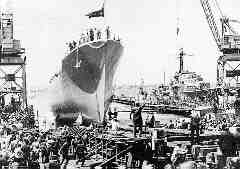 |  |
| HMAS Swan slides down the slipway | HMAS Swan nearing Garden Island in Sydney Harbour |
The two new ships differed quite a deal from the previous four vessels. While the hulls were similar, there were major differences in the superstructure, armaments and other electronic features. While the earlier ships had a single level superstructure, the Swan and Torrens had two levels extending back from the bridge to just aft of amidships. In addition, the two new ships had stabilisers whereas the others did not.
Another major difference was that the two new ships had sterns that were level with the main deck while the Parramatta and Yarra stepped down to the next level. The Derwent and Stuart had sterns that were also level with the main deck but were cut down on the starboard side aft. In fact, all of the six ships looked quite different to each other and could easily be confused as being different class vessels.
Meanwhile, the Swan and Torrens had a small aperture on the starboard side just forward of the stern. These apertures were to house the Ikara anti-submarine missile launchers. In the case of the Swan, the aperture had twin doors on the forward end and a single door into the hull main area. The main gun was a turret with twin 4.5 inch/45 Mk 6 guns capable of sending a shell over six kilometres. This was mounted in front of the bridge. Other armaments on the Swan included a Limbo Mk 10 ASW anti-submarine mortar (with triple launchers) located in the centre of the ship forward of the Ikara launcher (this was later removed and the area became the ship's gymnasium). At the rear of the superstructure there was a Seacat M22 SAM (surface to air missile) launcher capable of firing four missiles at a time. There were also four 0.5 inch Browning machine guns.
After commissioning, the Swan (fondly known as "Fluffy Duck" by her crew) was based in Sydney. During 1971, the Swan took part in exercise "Swan Lake" in the Indian Ocean. Although the Vietnam War was on at this time, the Swan only had a limited involvement in it. From 4 October till 14 October 1971 she escorted Australian vessels to the war zone and again from 6 December till 11 December 1971. In late 1974 or early 1975, the Swan was in the ANZUK Force operating out of Singapore and was relieved by HMAS Derwent in March 1975. She saw no action during her whole career.
HMAS Swan was the first RAN ship to visit China since its civil war, visiting Shanghai on 3 September 1981, more than 32 years after the last Australian visit. The ship stayed four days.
Another first for the Swan was the fact that she was the first and only Australian destroyer to have been slipped in Fremantle. This was on 28 October 1983 when the ship was taken into the Western Australian Public Works No. 1 Slipway and subjected to two weeks of maintenance. Not only, she was the largest and longest vessel to be slipped in Fremantle. In 1984, the Swan began a refit. I am not sure when it was completed, presumably late 1985 when she moved to HMAS Stirling Naval Base in Western Australia.
On 13 September 1996, HMAS Swan was decommissioned from the Royal Australian Navy. During her career, HMAS Swan steamed almost 800,000 nautical miles.
In 1995 the Australian Government indicated that HMAS Swan would be given to the Government of Western Australia. The WA Government then advertised for expressions of interest for a future use of the ship. The applications received were then considered by the HMAS Swan Steering Committee (which included environmental, industry, marine safety and marine transport representatives). The majority of the expressions suggested sinking the ship as a dive site (one was for it to be preserved as a floating museum but this was withdrawn when they realised most equipment was to be removed for spares). The committee decided that the ship should be given to the Geographe Bay Artificial Reef Society as it was the best overall submission in terms of the final use of the vessel. One of the major reasons for the decision when it was announced by the Minister for Tourism on 11 November 1996 was that the sinking location was the safest, most sheltered site which would provide maximum location for divers.
 | 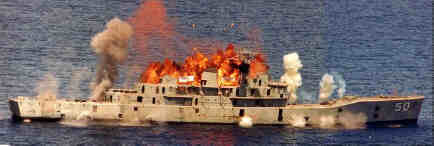 | 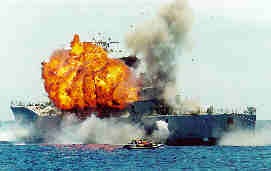 |
The access holes cut in the starboard side of the hull
are very evident in this photo | Spectacular explosions make the event even more exciting!! | Another view of the explosion, made more spectacular
by judicious placing of extra pyrotechnics |
The Society proposed to sink the Swan in Geographe Bay about 1.3 nautical miles off the shore near Cape Naturaliste, west of Busselton, about 255 kilometres south of Perth (by road). A few days later the Minister announced that the gun turret from the ship was going to be donated to Albany for display at the historic Princess Royal Fortress.
The ship was moved to Bunbury where over the next year, the Geographe Bay Artificial Reef Society worked to prepare the ship for sinking. As well as cleaning the ship (removing all traces of oil from the bilges and tanks), all electrical cabling, false ceilings and insulation had to be removed. One of the major task was to make the ship as safe as possible for all divers. This involved sealing some compartments (the engine room is inaccessible, the entrances having being grated over) and cutting dozens of access holes in the hull (there are 14 alone in the starboard side and two at the stern) and between compartments. The cost of doing this work was assisted by a grant from local councils, donations, fees paid by the public to inspect the ship when being prepared and income from the sale of lead ballast and copper wiring. There was also a raffle with the first prize being the right to press the button and set off the explosions.
On 15 November 1997, the gun turret from HMAS Swan was presented to the city of Albany by the Minister for Tourism, Mr Norman Moore. It is now on display at the Princess Royal Fortress.
Once the ship was ready, final preparations were made for the sinking. An expert from Canada was brought to Australia to advise on setting the charges for the sinking. This, of course, is a very important part of the operation. The main aim is to make the ship sit upright on the bottom so that the diving experience is made not only safer, but easier and more interesting. To this end, the expert placed six sets of explosives towards the bow (all three metres below the "waterline"), and four sets at the aft.
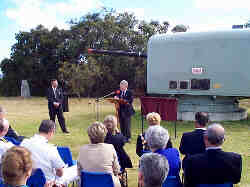 | 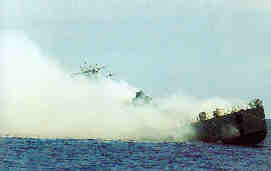 |
| The gun of the former HMAS Swan being presented to Albany | The Swan is almost gone |
Finally, all was ready and a few days before 14 December 1997, HMAS Swan was towed from her temporary berth at Bunbury to the scuttling location off Dunsborough. On 14 December 1997, an estimated 20,000 spectators, both on shore and aboard the 300 vessels surrounding the ship, waited for the event. The final Commanding Officer of the ship, Commander Alan Johnston, was present.
The winner of the raffle for the right to send the Swan to her new home was a Mr Famlonga, a local from Dunsborough. He gave his six year old son, Tyson, the chance to enter history by setting off the ten explosions. Three minutes and fifty-three seconds after young Tyson pushed the button, HMAS Swan went to the bottom. An hour after, divers from the Australian Clearance Diving Team Four (based at Stirling RAN Base) checked that all ten charges had exploded and the ship was then handed over to the Society.
Today, diving on the Swan is controlled by the Geographe Bay Artificial Reef Society (which was given the right by the Government to set rules about access to the vessel). Charter boats must pay a few for the right to dive on the ship and private vessels can also apply for a permit (this is far more enlightened than New South Wales where permits to dive the historic SS Lady Darling are refused to private boats).
In June 1998 I travelled to Western Australia specifically to dive the wreck of the Swan. For information on how to get to the the wreck location (especially for easterners), see my article entitled Dunsborough - Home of HMAS Swan. For details on my dives on the wreck, see the article on the dives.
I used and can certainly recommend the services of Cape Dive and Tackle. Price for a double dive, including tanks and weight belts was $75. Contact Shelley on 08 9756 8778, the shop is located at 222 Naturaliste Terrace, Dunsborough.
Note:
Michael McFadyen travelled to Western Australia using his own funds and dived courtesy of his own money, so he reserves the right to mention the dive operator he actually used and enjoyed.
References:
| 
 v6.00.307 © 2003-2005
v6.00.307 © 2003-2005